Abstract
A hospital-based case-control study was undertaken to examine the role of human papillomavirus (HPV) in the development of invasive cervical cancer in Brazil. The study included 199 histologically confirmed incident cases and 225 age-frequency-matched controls selected from a wide range of diagnostic categories. A polymerase chain reaction technique was used to detect HPV DNA in cervical specimens collected with spatula and brush. HPV DNA was detected in 84% of the cases compared with 17% of controls. Grouping HPV types 16, 18, 31 and 33, 66% of the cases were positive compared with only 6% of the controls. In addition to HPV, number of sexual partners, early age at first intercourse, parity and duration of oral contraceptive use were significantly associated with an increased risk of cervical cancer. A history of previous Papanicolaou smears was significantly associated with a decreased risk. After adjustment, only presence of HPV DNA, parity and history of previous smears remained as independent risk factors. The adjusted odds ratios of cervical cancer associated with HPV 16, 18, 31, and 33 was 69.7 (95% confidence interval 28.7-169.6) and with unidentified types was 12.0 (5.1-28.5). The very high risks found in this study further implicate this virus in the aetiology of cervical cancer.
Full text
PDF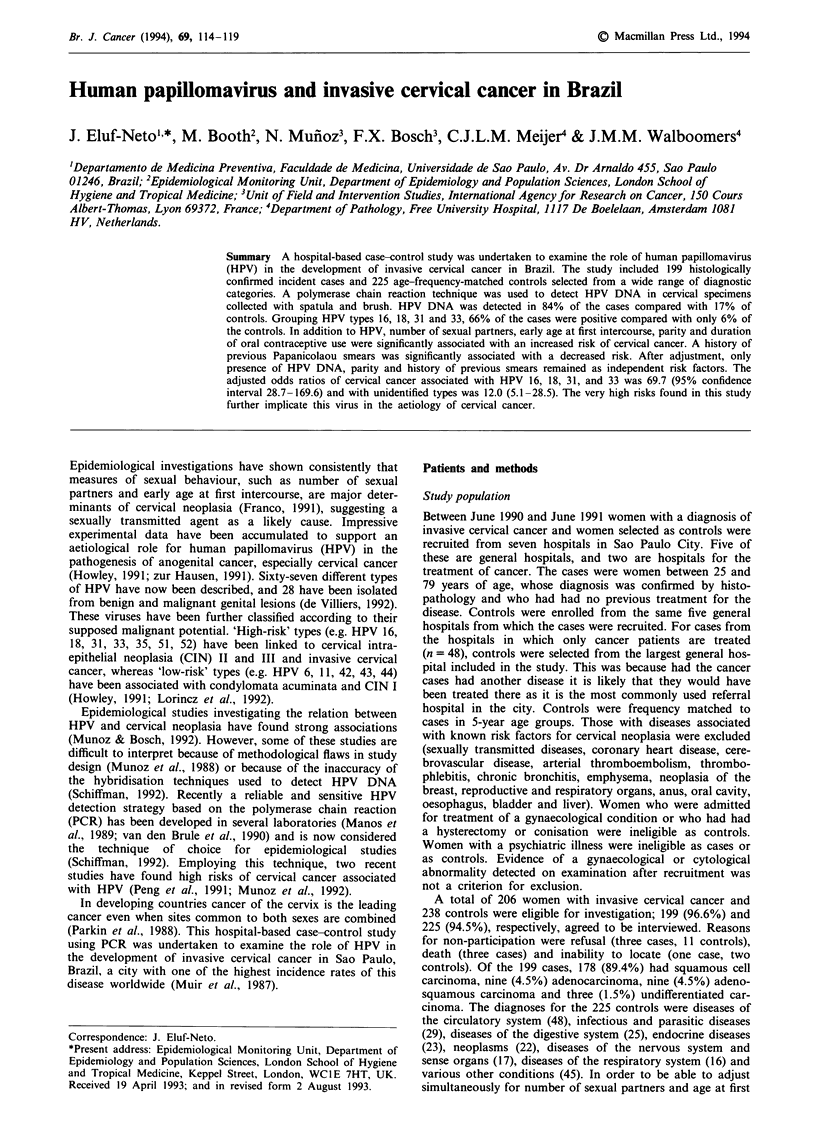
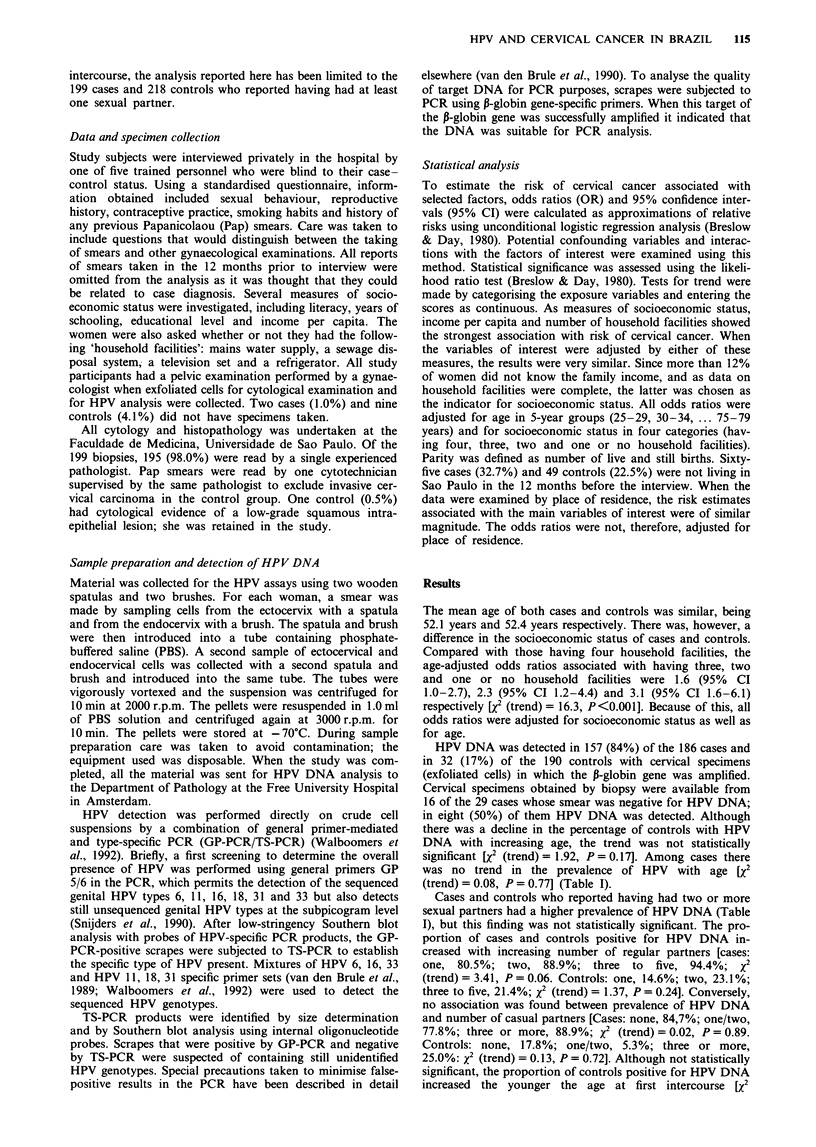
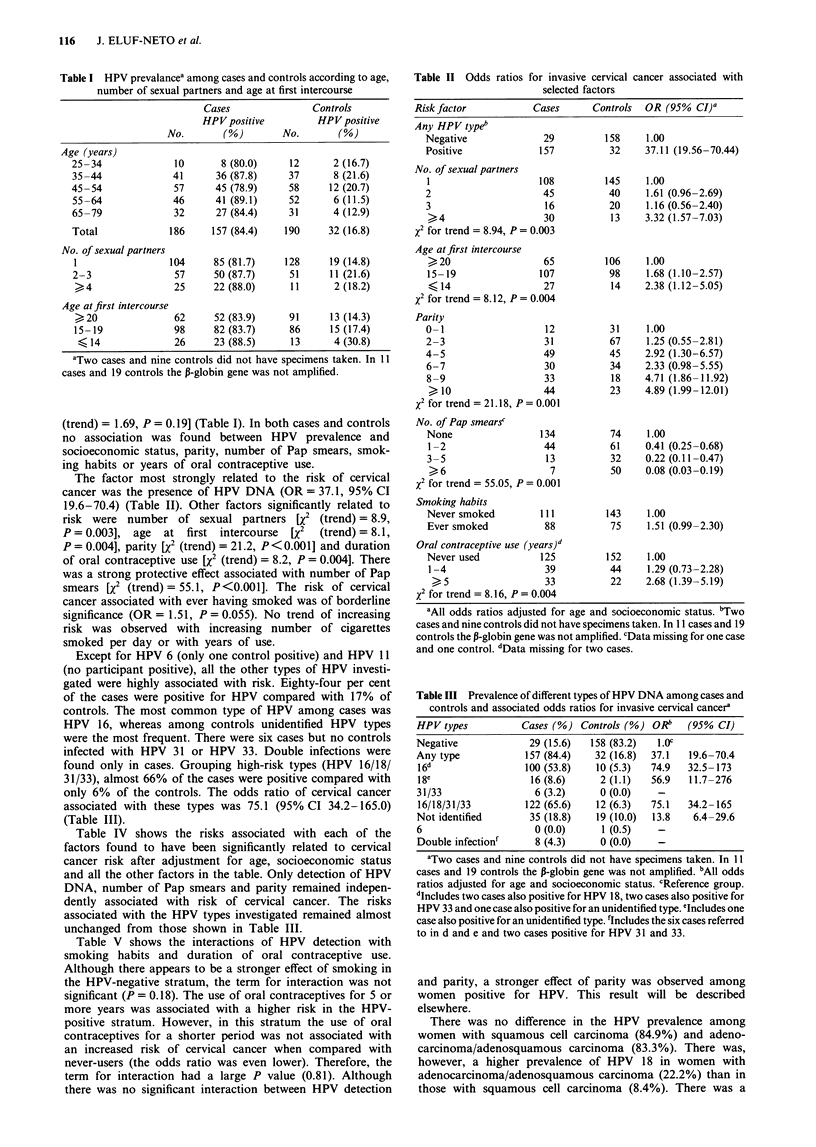
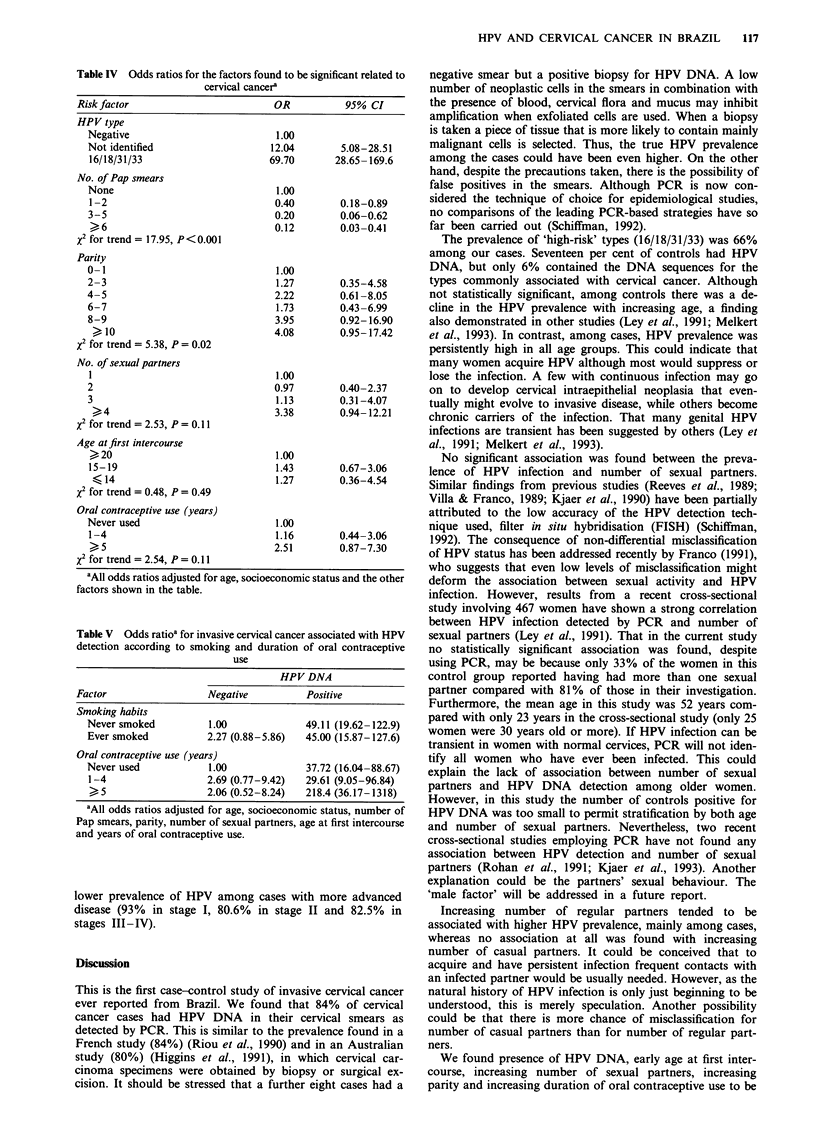
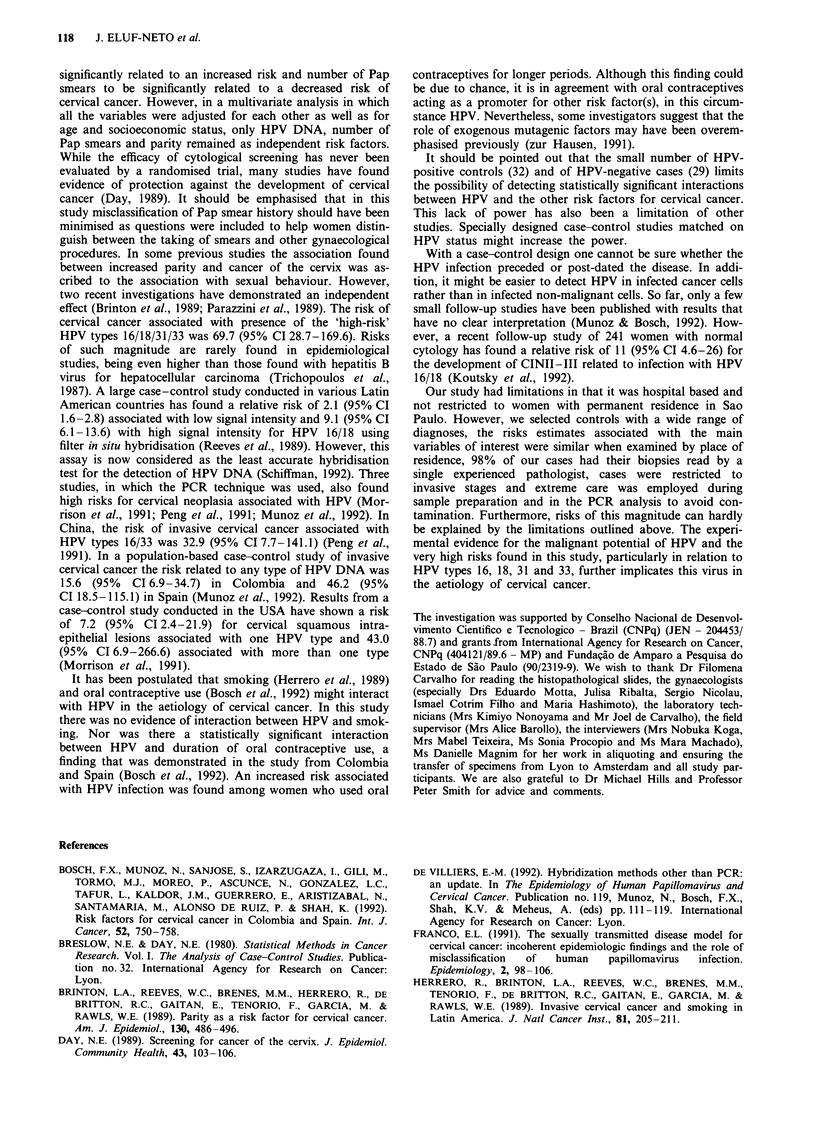
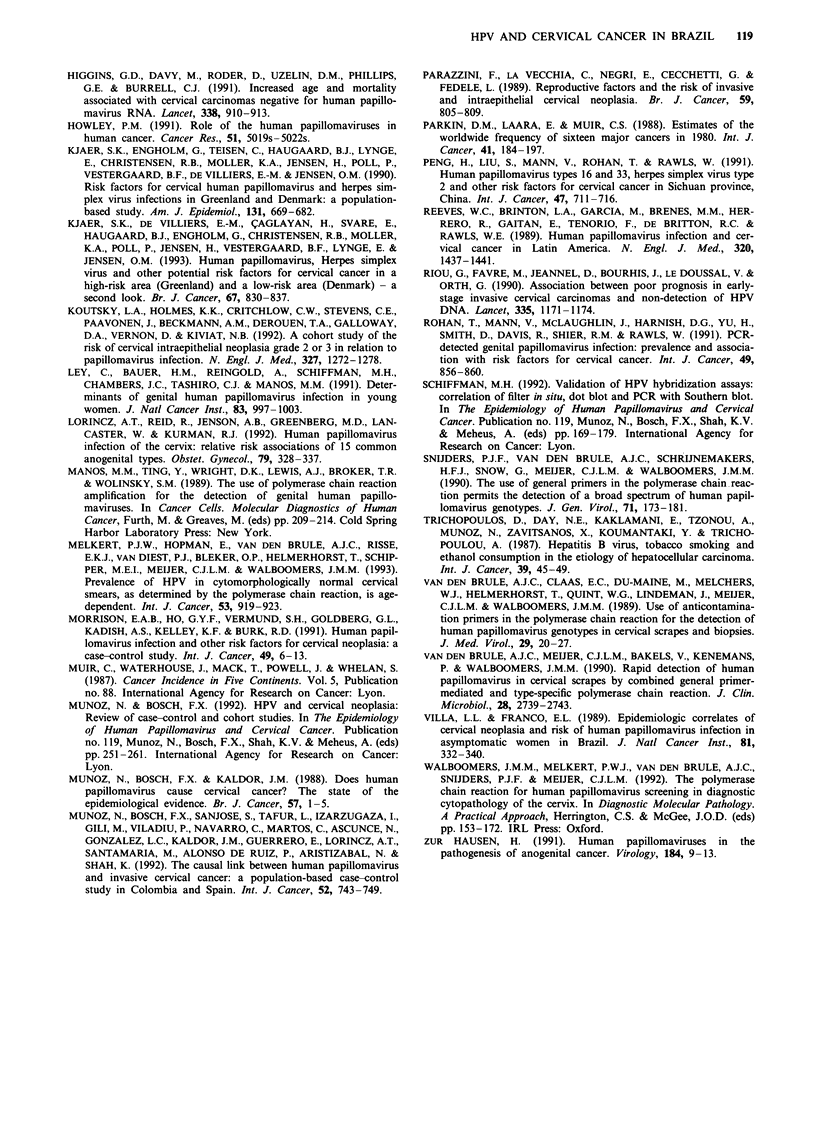
Selected References
These references are in PubMed. This may not be the complete list of references from this article.
- Brinton L. A., Reeves W. C., Brenes M. M., Herrero R., de Britton R. C., Gaitan E., Tenorio F., Garcia M., Rawls W. E. Parity as a risk factor for cervical cancer. Am J Epidemiol. 1989 Sep;130(3):486–496. doi: 10.1093/oxfordjournals.aje.a115362. [DOI] [PubMed] [Google Scholar]
- Day N. E. Screening for cancer of the cervix. J Epidemiol Community Health. 1989 Jun;43(2):103–106. doi: 10.1136/jech.43.2.103. [DOI] [PMC free article] [PubMed] [Google Scholar]
- Franco E. L. The sexually transmitted disease model for cervical cancer: incoherent epidemiologic findings and the role of misclassification of human papillomavirus infection. Epidemiology. 1991 Mar;2(2):98–106. [PubMed] [Google Scholar]
- Herrero R., Brinton L. A., Reeves W. C., Brenes M. M., Tenorio F., de Britton R. C., Gaitan E., Garcia M., Rawls W. E. Invasive cervical cancer and smoking in Latin America. J Natl Cancer Inst. 1989 Feb 1;81(3):205–211. doi: 10.1093/jnci/81.3.205. [DOI] [PubMed] [Google Scholar]
- Higgins G. D., Davy M., Roder D., Uzelin D. M., Phillips G. E., Burrell C. J. Increased age and mortality associated with cervical carcinomas negative for human papillomavirus RNA. Lancet. 1991 Oct 12;338(8772):910–913. doi: 10.1016/0140-6736(91)91773-n. [DOI] [PubMed] [Google Scholar]
- Howley P. M. Role of the human papillomaviruses in human cancer. Cancer Res. 1991 Sep 15;51(18 Suppl):5019s–5022s. [PubMed] [Google Scholar]
- Kjaer S. K., Engholm G., Teisen C., Haugaard B. J., Lynge E., Christensen R. B., Møller K. A., Jensen H., Poll P., Vestergaard B. F. Risk factors for cervical human papillomavirus and herpes simplex virus infections in Greenland and Denmark: a population-based study. Am J Epidemiol. 1990 Apr;131(4):669–682. doi: 10.1093/oxfordjournals.aje.a115551. [DOI] [PubMed] [Google Scholar]
- Kjaer S. K., de Villiers E. M., Cağlayan H., Svare E., Haugaard B. J., Engholm G., Christensen R. B., Møller K. A., Poll P., Jensen H. Human papillomavirus, herpes simplex virus and other potential risk factors for cervical cancer in a high-risk area (Greenland) and a low-risk area (Denmark)--a second look. Br J Cancer. 1993 Apr;67(4):830–837. doi: 10.1038/bjc.1993.152. [DOI] [PMC free article] [PubMed] [Google Scholar]
- Koutsky L. A., Holmes K. K., Critchlow C. W., Stevens C. E., Paavonen J., Beckmann A. M., DeRouen T. A., Galloway D. A., Vernon D., Kiviat N. B. A cohort study of the risk of cervical intraepithelial neoplasia grade 2 or 3 in relation to papillomavirus infection. N Engl J Med. 1992 Oct 29;327(18):1272–1278. doi: 10.1056/NEJM199210293271804. [DOI] [PubMed] [Google Scholar]
- Ley C., Bauer H. M., Reingold A., Schiffman M. H., Chambers J. C., Tashiro C. J., Manos M. M. Determinants of genital human papillomavirus infection in young women. J Natl Cancer Inst. 1991 Jul 17;83(14):997–1003. doi: 10.1093/jnci/83.14.997. [DOI] [PubMed] [Google Scholar]
- Lorincz A. T., Reid R., Jenson A. B., Greenberg M. D., Lancaster W., Kurman R. J. Human papillomavirus infection of the cervix: relative risk associations of 15 common anogenital types. Obstet Gynecol. 1992 Mar;79(3):328–337. doi: 10.1097/00006250-199203000-00002. [DOI] [PubMed] [Google Scholar]
- Melkert P. W., Hopman E., van den Brule A. J., Risse E. K., van Diest P. J., Bleker O. P., Helmerhorst T., Schipper M. E., Meijer C. J., Walboomers J. M. Prevalence of HPV in cytomorphologically normal cervical smears, as determined by the polymerase chain reaction, is age-dependent. Int J Cancer. 1993 Apr 1;53(6):919–923. doi: 10.1002/ijc.2910530609. [DOI] [PubMed] [Google Scholar]
- Morrison E. A., Ho G. Y., Vermund S. H., Goldberg G. L., Kadish A. S., Kelley K. F., Burk R. D. Human papillomavirus infection and other risk factors for cervical neoplasia: a case-control study. Int J Cancer. 1991 Aug 19;49(1):6–13. doi: 10.1002/ijc.2910490103. [DOI] [PubMed] [Google Scholar]
- Muñoz N., Bosch F. X., de Sanjosé S., Tafur L., Izarzugaza I., Gili M., Viladiu P., Navarro C., Martos C., Ascunce N. The causal link between human papillomavirus and invasive cervical cancer: a population-based case-control study in Colombia and Spain. Int J Cancer. 1992 Nov 11;52(5):743–749. doi: 10.1002/ijc.2910520513. [DOI] [PubMed] [Google Scholar]
- Muñoz N., Bosch X., Kaldor J. M. Does human papillomavirus cause cervical cancer? The state of the epidemiological evidence. Br J Cancer. 1988 Jan;57(1):1–5. doi: 10.1038/bjc.1988.1. [DOI] [PMC free article] [PubMed] [Google Scholar]
- Parazzini F., La Vecchia C., Negri E., Cecchetti G., Fedele L. Reproductive factors and the risk of invasive and intraepithelial cervical neoplasia. Br J Cancer. 1989 May;59(5):805–809. doi: 10.1038/bjc.1989.168. [DOI] [PMC free article] [PubMed] [Google Scholar]
- Parkin D. M., Lärä E., Muir C. S. Estimates of the worldwide frequency of sixteen major cancers in 1980. Int J Cancer. 1988 Feb 15;41(2):184–197. doi: 10.1002/ijc.2910410205. [DOI] [PubMed] [Google Scholar]
- Peng H. Q., Liu S. L., Mann V., Rohan T., Rawls W. Human papillomavirus types 16 and 33, herpes simplex virus type 2 and other risk factors for cervical cancer in Sichuan Province, China. Int J Cancer. 1991 Mar 12;47(5):711–716. doi: 10.1002/ijc.2910470515. [DOI] [PubMed] [Google Scholar]
- Reeves W. C., Brinton L. A., García M., Brenes M. M., Herrero R., Gaitán E., Tenorio F., de Britton R. C., Rawls W. E. Human papillomavirus infection and cervical cancer in Latin America. N Engl J Med. 1989 Jun 1;320(22):1437–1441. doi: 10.1056/NEJM198906013202201. [DOI] [PubMed] [Google Scholar]
- Riou G., Favre M., Jeannel D., Bourhis J., Le Doussal V., Orth G. Association between poor prognosis in early-stage invasive cervical carcinomas and non-detection of HPV DNA. Lancet. 1990 May 19;335(8699):1171–1174. doi: 10.1016/0140-6736(90)92693-c. [DOI] [PubMed] [Google Scholar]
- Rohan T., Mann V., McLaughlin J., Harnish D. G., Yu H., Smith D., Davis R., Shier R. M., Rawls W. PCR-detected genital papillomavirus infection: prevalence and association with risk factors for cervical cancer. Int J Cancer. 1991 Dec 2;49(6):856–860. doi: 10.1002/ijc.2910490609. [DOI] [PubMed] [Google Scholar]
- Snijders P. J., van den Brule A. J., Schrijnemakers H. F., Snow G., Meijer C. J., Walboomers J. M. The use of general primers in the polymerase chain reaction permits the detection of a broad spectrum of human papillomavirus genotypes. J Gen Virol. 1990 Jan;71(Pt 1):173–181. doi: 10.1099/0022-1317-71-1-173. [DOI] [PubMed] [Google Scholar]
- Trichopoulos D., Day N. E., Kaklamani E., Tzonou A., Muñoz N., Zavitsanos X., Koumantaki Y., Trichopoulou A. Hepatitis B virus, tobacco smoking and ethanol consumption in the etiology of hepatocellular carcinoma. Int J Cancer. 1987 Jan 15;39(1):45–49. doi: 10.1002/ijc.2910390109. [DOI] [PubMed] [Google Scholar]
- Villa L. L., Franco E. L. Epidemiologic correlates of cervical neoplasia and risk of human papillomavirus infection in asymptomatic women in Brazil. J Natl Cancer Inst. 1989 Mar 1;81(5):332–340. doi: 10.1093/jnci/81.5.332. [DOI] [PubMed] [Google Scholar]
- van den Brule A. J., Claas E. C., du Maine M., Melchers W. J., Helmerhorst T., Quint W. G., Lindeman J., Meijer C. J., Walboomers J. M. Use of anticontamination primers in the polymerase chain reaction for the detection of human papilloma virus genotypes in cervical scrapes and biopsies. J Med Virol. 1989 Sep;29(1):20–27. doi: 10.1002/jmv.1890290105. [DOI] [PubMed] [Google Scholar]
- van den Brule A. J., Meijer C. J., Bakels V., Kenemans P., Walboomers J. M. Rapid detection of human papillomavirus in cervical scrapes by combined general primer-mediated and type-specific polymerase chain reaction. J Clin Microbiol. 1990 Dec;28(12):2739–2743. doi: 10.1128/jcm.28.12.2739-2743.1990. [DOI] [PMC free article] [PubMed] [Google Scholar]
- zur Hausen H. Human papillomaviruses in the pathogenesis of anogenital cancer. Virology. 1991 Sep;184(1):9–13. doi: 10.1016/0042-6822(91)90816-t. [DOI] [PubMed] [Google Scholar]


